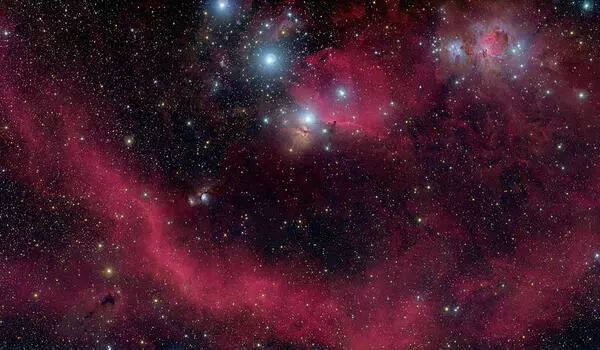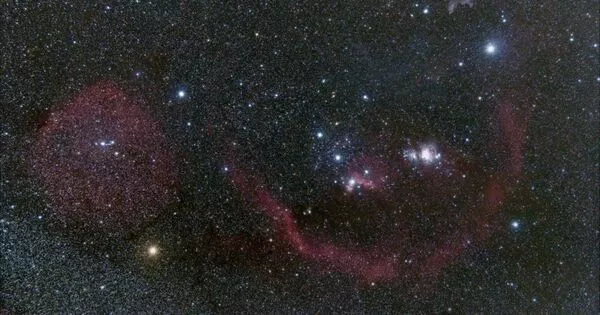Barnard’s Loop is a large, elliptical nebula that surrounds the central region of the Orion Molecular Cloud Complex. It is named after its discoverer, American astronomer E.E. Barnard, and is estimated to be around 200 light-years in diameter. The nebula is thought to be the result of a supernova explosion that occurred several million years ago and is one of the most prominent features in the night sky for observers in the southern hemisphere.
The Barnard’s Loop is a stunning emission nebula visible with the naked eye. It is estimated to stretch across an arc 100 light-years to 300 light-years across. It is approximately 1,484 light-years from Earth. It is made of plasma, and the primary red color is caused by hydrogen gas.
Barnard’s Loop is thought to have formed as a result of a supernova explosion about 2 million years ago, which also produced several known runaway stars, including AE Aurigae, Mu Columbae, and 53 Arietis. These stars are thought to be part of a multi-star system, with one component exploding as a supernova.

Barnard’s Loop is an emission nebula in Orion’s constellation. It is a component of the Orion molecular cloud complex, which includes the dark Horsehead and bright Orion nebulae. The loop is shaped like a large arc and is roughly centered on the Orion Nebula. The Orion Nebula stars are thought to be responsible for ionizing the loop. The loop covers much of Orion and spans about 600 arcminutes as seen from Earth. Long-exposure photographs show it well, but observers under very dark skies may be able to see it with the naked eye.
Recent estimates place it at a distance of 159 pc (518 light years) or 440 pc (1434 ly), giving it dimensions of about 100 or 300 ly. It is thought to have been created by a supernova explosion about 2 million years ago, which may also have created several known runaway stars, including AE Aurigae, Mu Columbae, and 53 Arietis, which are thought to have been part of a multiple star system in which one component exploded as a supernova.
Barnard’s Loop is a large, circular-shaped nebula that encompasses several well-known objects in Orion, including the Orion Nebula and the Horsehead Nebula. It is believed to have been formed by a supernova explosion that occurred several million years ago, and is now a region of active star formation. Although this faint nebula was certainly observed by earlier astronomers, it is named after the pioneering astrophotographer E. E. Barnard who photographed it and published a description in 1894.
It is an H-alpha emitting region of ionized hydrogen, which appears as a red loop-like structure in the night sky. It is named after American astronomer E. E. Barnard, who discovered it in 1894. Barnard’s Loop is estimated to be approximately 250 light-years in diameter and is believed to be a remnant of a supernova explosion that occurred around 2 million years ago.
















